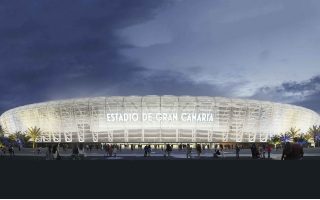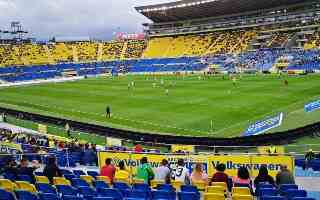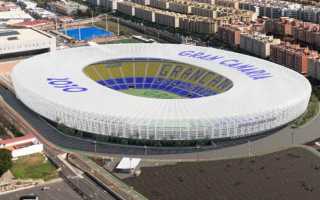Estadio Gran Canaria
| Capacity | 44 462 |
|---|---|
| Country | Spain |
| City | Las Palmas |
| Clubs | UD Las Palmas |
| Category | Design outdated |
| Cost | €107 M ($117.5 M) |
| Construction | 07/2025 – 06/2027 |
Advertisement
Estadio Gran Canaria – design description
Why was the next reconstruction of Estadio Gran Canaria planned?
The Estadio Gran Canaria in Las Palmas was inaugurated on May 8, 2003, and was originally a facility with an athletics track. Between 2014 and 2016, the stadium was upgraded, removing the running track and bringing the stands closer to the pitch. With a capacity of 32,400 spectators, it is the largest stadium in the Canary Islands.
The first reports about the local authorities' plans for another stadium reconstruction came in the summer of 2022. The impetus for the move was the desire to join the initiative to host the 2030 World Cup. Spain intended to bid to host the World Cup together with Portugal and Morocco. To host World Cup matches, the venue would have to be expanded to a capacity of at least 40,000 spectators.
On May 18, 2023, the stadium was visited by a committee evaluating the preparation of individual cities and facilities for the possible hosting of the World Cup. On May 25, 2023, the president of the council (cabildo) that governs the island of Gran Canaria presented the first renderings to the wider public, showing how the stadium was planned to be redeveloped.
What did the Estadio Gran Canaria redevelopment project entail?
The plan was to expand the northern curve (Grada Naciente) so that it equaled the height of the rest of the auditorium. The stands were then to form a compact, enclosed oval around the pitch. Then an additional, not very high ring of auditoriums was to be added at the top (except for the main stand, where a building with boxes already stretched along the top edge). The stadium would also receive a new roof over all the stands, merging into one with the facade.
The modernization was to complement the 2014–2016 reconstruction, and the implementation of the project would give the stadium a more cohesive and modern look. The capacity of the stands would have increased to 44,462 spectators, allowing the venue to compete for entry into the 2030 World Cup host cities. The expansion would also have created better conditions for the UD Las Palmas club, which secured promotion to the LaLiga competition two days after the project presentation.
How did the Estadio Gran Canaria expansion project proceed?
On October 4, 2023, FIFA announced that Spain had been awarded the hosting of the 2030 World Cup (along with Morocco and Portugal, as well as three South American countries that are to host only one game each at the start of the tournament: Argentina, Uruguay and Paraguay).
What's more, the Estadio Gran Canaria was on the list of venues for the World Cup. However, instead of realizing the design presented in May 2023, the authorities organized an architectural competition for a new concept, which was entered by a number of renowned studios from around the world.
The selection of the winning concept was announced on February 7, 2024. Its author was the L35 Arquitectos studio, and it was this design for the Estadio Gran Canaria expansion that was slated for implementation.
Advertisement
Renderings

2023 © Antonio Morales Méndez 
2023 © Antonio Morales Méndez 
2023 © Antonio Morales Méndez
Related news
2024
-

Spain: Stands at Las Palmas stadium to be closer to the pitch
As early as next year, long-awaited modernisation work will begin at the Estadio de Gran Canaria, which will see the construction of a new canopy. In addition, the Curva and Naciente stands will need to be brought closer together, the councillor relayed.
-

WC 2030: Nine companies interested in modernizing Estadio Gran Canaria
Through the Insular Sports Institute, the Cabildo will introduce recreational and commercial services to the stadium, ensuring financial stability and reclaiming “every last euro” of an investment exceeding €100 million.
-

Spain: Wave of stadium upgrades sweeps through the Iberian Peninsula
In recent years, work on Spanish stadiums has not stopped, and the 2030 World Cup has provided another important impetus for the renovation of facilities. With work on the Bernabéu, Camp Nou and Balaídos already underway, 9 La Liga venues are awaiting their turn. Rosaleda, Romareda, Riazor and La Cartuja join the group as 2030 World Cup hosts.
-

Spain: What will Canary Islands stadium look like during World Cup 2030?
Estadio Gran Canaria will be one of the venues for the 2030 World Cup. The candidacy presented by the Island Council passed all levels of FIFA verification and is one of eleven that the Royal Spanish Football Federation (RFEF) will submit in the official document.
-

World Cup 2030: Spain selected 11 stadiums. Which ones are missing?
By July 31, Spain will present to FIFA the stadiums that, along with venues in Morocco and Portugal, will be part of the 2030 World Cup. The idea of proposing as many as 13 arenas was rejected, and ultimately, only eleven will be presented.
-

Spain: Estadio Gran Canaria prepares for 2024/25 season
UD Las Palmas' stadium is undergoing "urgent and necessary" changes to prepare the facility for the upcoming season and to avoid further sanctions for failing to meet La Liga standards. On the horizon, however, is a deeper redevelopment, the project of which has given the Canary Islands the hosting of the 2030 World Cup and will fundamentally change the Canarian arena.
-

World Cup 2030: The race for the final (and more) enters decisive phase
Recent weeks have been tumultuous for the candidate cities, but the next few weeks will be a real storm. Of the 14 Spanish arenas aspiring to host the World Cup, only 11 will be chosen. Bernabéu, Camp Nou and Grand Stade de Casablanca are vying to host the finals, although the Moroccan megastadion exists only on paper for now.
 StadiumDB
StadiumDB